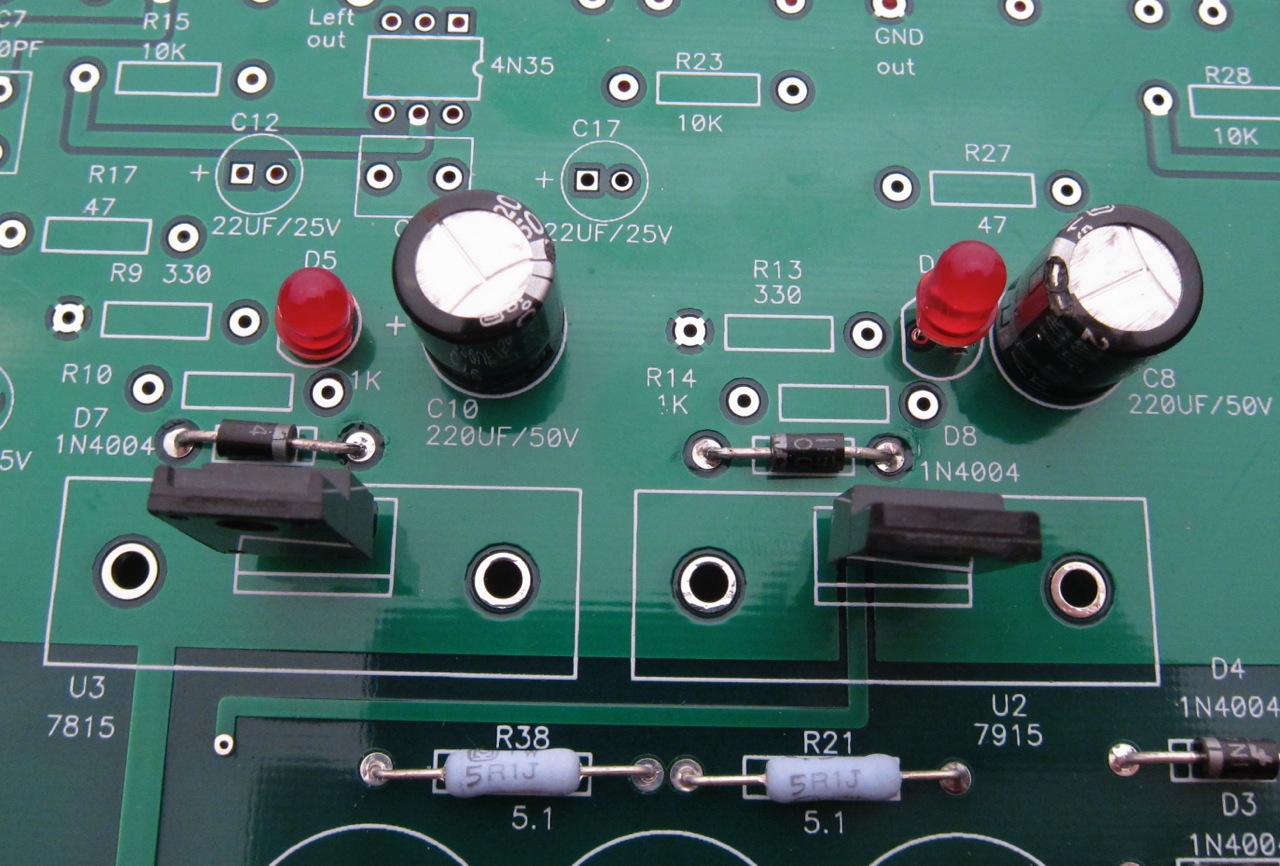LED Extinguishing Times
-🙂
I am pretty sure that before I shorted the LEDs they both extinguished at pretty much the same time too - certainly any difference wasn't noticeable.
The 7915 LED extinguishes in 17 seconds. The 7815 LED extinguishes in over 2 minutes. I wouldn't expect both sides to be identical because of the tolerances on every component, but this seems OTT, which makes me think there is something wrong with one side - but which one ? Which side is probably about right ? (Or are they both wrong ?)
All I have changed are regulators, diodes and LEDs. I have spare LEDs and diodes, so I could change them out again. I could also get some more 7915 and 7815.
I just checked two with blue LED's and the turn off almost at the same time.😕
-🙂
I am pretty sure that before I shorted the LEDs they both extinguished at pretty much the same time too - certainly any difference wasn't noticeable.
The 7915 LED extinguishes in 17 seconds. The 7815 LED extinguishes in over 2 minutes. I wouldn't expect both sides to be identical because of the tolerances on every component, but this seems OTT, which makes me think there is something wrong with one side - but which one ? Which side is probably about right ? (Or are they both wrong ?)
All I have changed are regulators, diodes and LEDs. I have spare LEDs and diodes, so I could change them out again. I could also get some more 7915 and 7815.
Asymmetric LM833 ?
It's a good point, but the datasheet schematic appears to show identical opamps for each side, and doesn't give any indication that the LM833 is not symmetrical. I can't think of any reason why it could be asymmetric - but I am no expert on the design of opamps. If I was the designer I would design one half and copy-paste it for the other half (with a 'flip' if required) !
Even if the circuit is nearly symmetrical, is the opamp? Couldn’t that account for some of the difference in draw between the two rails?
It's a good point, but the datasheet schematic appears to show identical opamps for each side, and doesn't give any indication that the LM833 is not symmetrical. I can't think of any reason why it could be asymmetric - but I am no expert on the design of opamps. If I was the designer I would design one half and copy-paste it for the other half (with a 'flip' if required) !
I have no idea if the opamp plays a role, but remember it’s not the channels that draw from each rail, they both draw from both.
http://www.ti.com/lit/ds/symlink/lm833-n.pdf
From the lm833 datasheet it does not look symmetrical, but it could be totally irrelevant to the question.
I used opa627 and noticed the same thing, though I didn’t time it, and the amp works beautifully.
http://www.ti.com/lit/ds/symlink/lm833-n.pdf
From the lm833 datasheet it does not look symmetrical, but it could be totally irrelevant to the question.
I used opa627 and noticed the same thing, though I didn’t time it, and the amp works beautifully.
Measure across the 47 Ohm resistors on the power power leads to the op amp. If the voltage drops are = so are the rail currents there.
Would it be too sacrilegious if one were to use a logo like this when creating the case for this incredible amp? 😱

or this one (a little less 'in your face' copy, but still a hint of relationship):

or this one (a little less 'in your face' copy, but still a hint of relationship):
Attachments
Last edited:
I used opa627 and noticed the same thing, though I didn’t time it, and the amp works beautifully.
I use an OPA2134 and I notice the same.
The Pass type font has a very strange "H"... but it works nicely as well:I was thinking of the Pass Labs logo
Attachments
I have no idea if the opamp plays a role, but remember it’s not the channels that draw from each rail, they both draw from both.
http://www.ti.com/lit/ds/symlink/lm833-n.pdf
From the lm833 datasheet it does not look symmetrical, but it could be totally irrelevant to the question.
I used opa627 and noticed the same thing, though I didn’t time it, and the amp works beautifully.
I see that as well with the opa627BP. Finished up the amp a few days ago first as a pre-amp. Added depth to the sound stage and made the speakers disappear. And it has given the Aleph J and F6 more bass and drum slam on all recordings. This thing was fun to build. Wired in the headphone jack yesterday. Its a hell of a head amp too. Thanks Wayne, 6l6 and all the builders and their comments. Couldn't do it without all your help.
Would it be too sacrilegious if one were to use a logo like this when creating the case for this incredible amp?
Sacrilegious? It's an incredibly goofy and silly name, made up by some clown who was trying to be clever and wasn't very successful! (me)
😀
I like the logo, though it looks a little like W-hammy, where ham is English for cured pork, Jamon? Jambon?
Would probably look wonderful made into one of your chassis. 🙂
I have no idea if the opamp plays a role, but remember it’s not the channels that draw from each rail, they both draw from both.
http://www.ti.com/lit/ds/symlink/lm833-n.pdf
From the lm833 datasheet it does not look symmetrical, but it could be totally irrelevant to the question.
I used opa627 and noticed the same thing, though I didn’t time it, and the amp works beautifully.
My amp sounds fine too. But then again, it sounded fine with 30V on the power pins of the opamp till I realised the LEDs were out !
I understand that the MOSFETS in the left and right channels draw power from the +ve and -ve rails, but can anyone explain how/why they would draw more current from the negative rail and extinguish the LED 7x faster than the +ve rail when you pull out the power plug ? (other than a fault).
47 ohm resistor voltages
Wayne,
The no load voltages across the 47 ohm resistors R35 and R36 are 0.223 and 0.224V respectively.
Any other diagnostic voltage checks that might explain the asymmetric draw would be welcome.
Measure across the 47 Ohm resistors on the power power leads to the op amp. If the voltage drops are = so are the rail currents there.
Wayne,
The no load voltages across the 47 ohm resistors R35 and R36 are 0.223 and 0.224V respectively.
Any other diagnostic voltage checks that might explain the asymmetric draw would be welcome.
Do you have one of the protection diodes in backwards? Or maybe not a good solder connection?
At this point I'm back to thinking it's a problem in the reg circuit.

At this point I'm back to thinking it's a problem in the reg circuit.

Do you have one of the protection diodes in backwards? Or maybe not a good solder connection?
At this point I'm back to thinking it's a problem in the reg circuit.

6L6
Both the diodes are in the right way round. I agree the problem is in the reg circuit as this was the last area I worked. I agree it could be a bad joint. I did notice that some of the pads are very small and not conducive to re-working. I will check all the joints when I get a chance.
Wayne,
The no load voltages across the 47 ohm resistors R35 and R36 are 0.223 and 0.224V respectively.
Any other diagnostic voltage checks that might explain the asymmetric draw would be welcome.
I am out of ideas here. The op amp draw looks good. Maybe what Jim has suggested the diodes brand of regulators? If the supply voltages are good maybe it doesn't matter. However it is a puzzle and I can't let those go.
I'm thinking of getting "Designed by" PASS cnc'd to my front panel using the PASS logo, do you think that would be appropriate and infact breach of some contract or copyright, would I need to get persmission.
They don't care if its a DIY project. There have been some really good looking ones over the years. 🙂 🙂
- Home
- Amplifiers
- Pass Labs
- "WHAMMY" Pass DIY headphone amp guide


